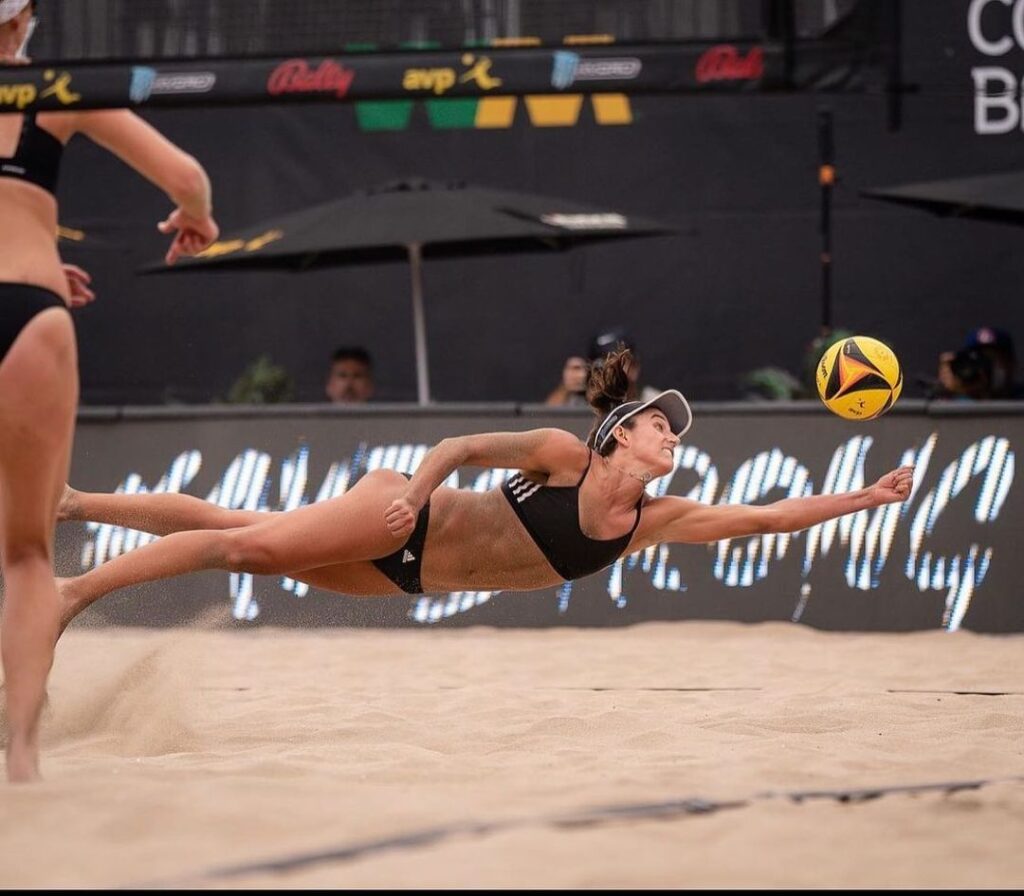In the context of employing an angle defense, the designated defender takes on the crucial role of retrieving balls targeted along the attacker’s line. This defensive strategy, widely employed for its effectiveness, provides the defender with the ability to retrieve balls that would be exceedingly challenging to manage when employing a line defense.
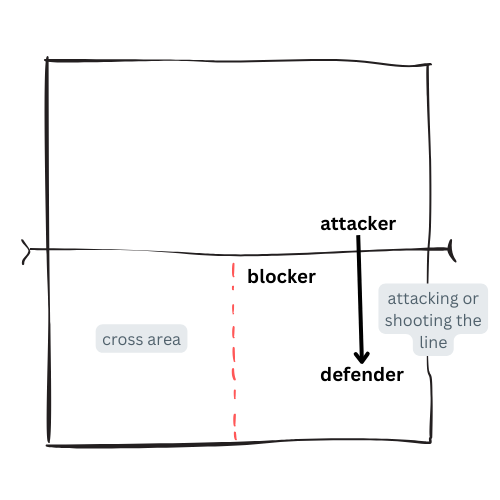
The defender’s task is to strategically position themselves in the line to retrieve a multitude of shots and hits. However, initiating this move too early carries the risk of telegraphing the defensive strategy, potentially allowing the opposing team to exploit the open court in the cross area. Consequently, in the majority of cases, the defender seeks to postpone their movement until the last possible moment.
The defender has various methods at their disposal to execute the movement to the line, each with its distinct set of advantages and disadvantages.
Last-Minute Maneuvers: Starting at Cross-Court and Shifting Tactics
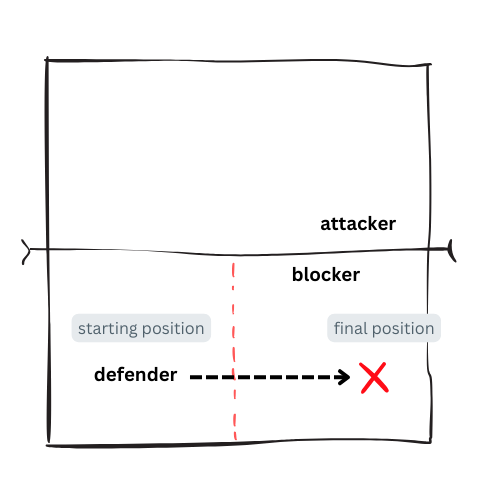
Arguably the most prevalent tactic involves the defender initially positioning themselves at the cross of the attacker, adopting a stance that suggests a line defense. The pivotal element for success in this defense lies in the timing of when to depart this position and swiftly transition to the line.
The defender exercises patience, holding their ground until after the set is executed. To maximize the deception of this defense, the defender strategically waits for the attacker to shift their gaze upwards to the ball. At this precise moment, the defender accelerates towards the line, aiming to intercept any shots directed to that area.
Weighing Pros and Cons: Advantages and Disadvantages
The primary advantage of this tactic lies in its deceptive quality. By initially showcasing a line defense and delaying movement until the last possible moment, there’s a heightened probability that the opposing team won’t recognize the defense in time, leading to an incorrect shot. Additionally, this approach can psychologically impact the attacker, planting the idea of a potential move to the line and influencing them to shoot an easily defendable ball to the defender’s hands when running a line defense.
Conversely, the main disadvantage surfaces in the extended distance the defender must cover during their journey to the final position. As the skill level escalates, opponents may exploit this by swiftly shooting the ball to the line, delivering powerful hits, or shooting a small baby line, leaving the defender struggling to reach their designated spot in time.
Starting at the Middle and Shifting Tactics at the Last Minute
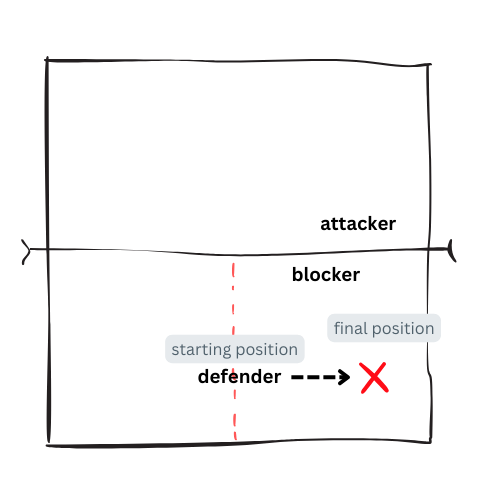
Another viable tactic for the defender involves initiating the movement from the middle of the court instead of the cross court. In this strategy, the defender adheres to a similar principle, waiting until after the set is executed and the attacker redirects their attention to the ball.
This tactic proves more effective when integrated into the defender’s overall strategy. By incorporating variability, the defender can occasionally start from the middle and then, at the last minute, shift to the cross for a line defense. This dynamic approach keeps the opposing team guessing, making it challenging for them to predict the defender’s movements consistently.
Weighing Pros and Cons: Advantages and Disadvantages
The primary advantage of this tactic, in contrast to waiting in the cross-court, lies in the shortened path the defender has to traverse to reach the line. This reduction in distance enhances the defender’s speed in getting to the final position while maintaining the deceptive nature of the defense.
However, a potential disadvantage arises when starting in the middle becomes a consistent signal for running to the line. If this approach is not occasionally employed for a line defense, it becomes more predictable, diminishing the element of surprise and making it easier for the opposing team to anticipate the defender’s target. Balancing the use of this tactic within a broader defensive strategy is crucial to maintain its effectiveness.
Deceptive Plays: Faking Movements from the Middle
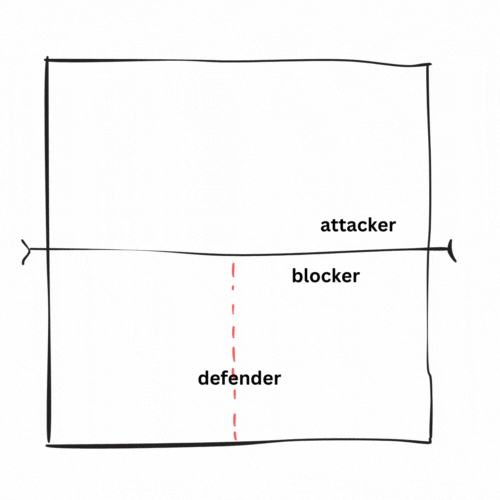
An additional tool in the defender’s arsenal involves incorporating extra movements before executing the run to the line. Unlike other mentioned tactics that emphasize stillness and late movement, this approach introduces a dynamic element, signaling that “something is in motion.” Immediately after the set, the defender executes a quick shuffle to the left or right, retraces their steps, and, in the final moments, sprints to the line. Most of the time the movement would be executed from the middle of the court.
This tactic serves a dual purpose: it confounds the setter, creating uncertainty in their call to the partner, and it introduces an element of psychological disruption for the attacker. The unpredictable movement, seen in the attacker’s peripheral vision, has the potential to unsettle them and disrupt their offensive strategy.
Weighing Pros and Cons: Advantages and Disadvantages
The advantage of this dynamic defensive approach lies in its efficacy in concealing the defender’s intended target. Beyond its strategic value, it serves as a psychological tactic, skillfully introducing a perplexing element for the hitter who may feel caught off guard and find themselves in a mental juggle, as the defender subtly ‘messes’ with their anticipations.
However, akin to the starting-from-the-middle tactic, this approach gains optimal effectiveness when integrated into a broader defensive strategy, preventing it from becoming predictably associated solely with a run to the line. Additionally, the intense movements preceding the run may pose challenges, potentially fatiguing the legs and, in turn, affecting the defender’s ability to accurately track the ball.
Unleashing Surprise Tactics: Initiating Play from the Line
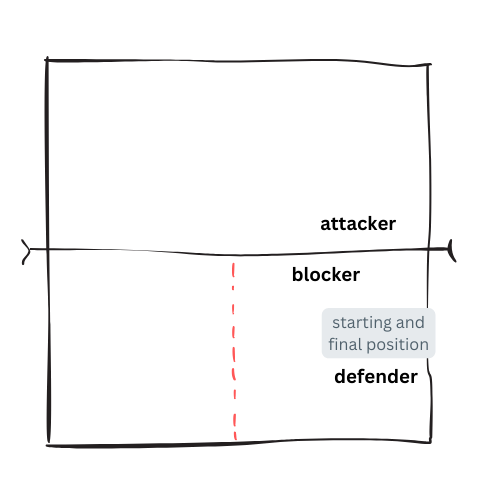
An intriguing yet underutilized tactic involves the defender positioning themselves early along the attacker’s line and patiently waiting for the shot or hit. This approach is relatively uncommon, and its rarity can lead to attackers overanalyzing the defender’s intentions. The uncertainty of whether the defender will stay on the line or shift back to the cross can play mind games with the attacker, potentially influencing them to opt for a shot or attack directly into the defender’s hands.
Weighing Pros and Cons: Advantages and Disadvantages
The primary advantage of this tactic lies in the element of surprise and the fact that the defender remains stationary, introducing an unexpected dimension to the defensive play. Upon reflection, there appears to be no inherent reason not to employ this defense tactic regularly. It shares similarities with a see-and-respond line defense where the defender patiently waits in the cross-court without making any movement.
As with preceding tactics, optimal results are likely when the defender occasionally runs back to the cross-court from this poised position, preventing the strategy from becoming predictably oriented solely toward staying along the line.
Final Thoughts
In the world of beach volleyball, defensive strategies vary widely among players. Some have a favorite go-to tactic they rely on consistently, while others prefer flexibility, adapting to different situations with a range of tactics. What works for one may not for another, and that’s the beauty of the game. It’s not about finding a single perfect tactic but about experimenting with different approaches. Players who explore and adapt to diverse tactics discover their own preferences and strengths. So, whether it’s a tried-and-true method or a mix of strategies, the key is to stay open-minded, try out different tactics, and find what works best for your style of play.
